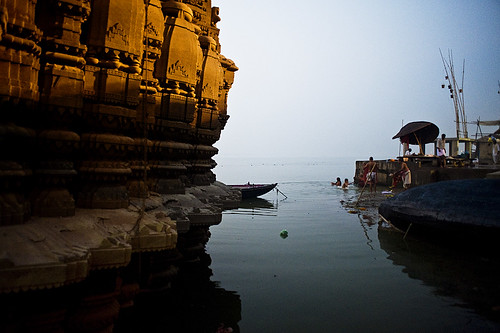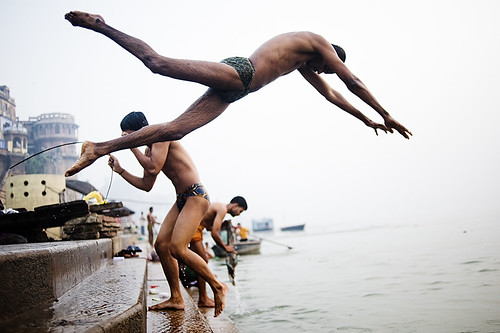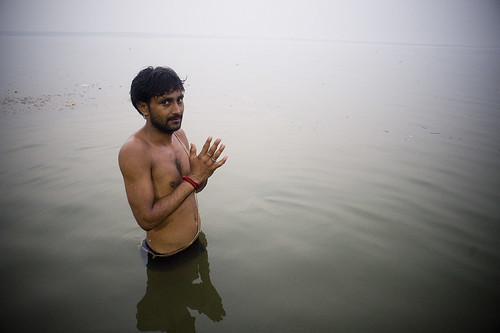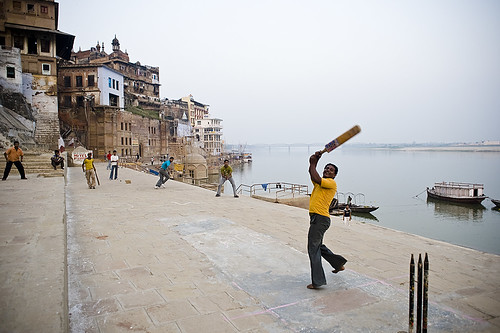India Diaries – Part 1
In the lead-up to my exhibition, Sons of Ganga, at The Cracked Gallery, I thought I would share excerpts from a journal I kept while on a journey through Northern India and Nepal in late 2008. The images in Sons of Ganga were taken in Varanasi, the oldest inhabited city in the world. Apologies for the rather turgid prose — I seem to get all circumlocutory in my writing when travelling.
Sunday, November 9th
Varanasi – Scindia Ghat
At Varanasi, India’s holiest city with its ghats descending into Mother Ganga. Varanasi holds you in a unique thrall — sitting on the ghat, looking out across the Ganges, one feels as though one is within a religious sanctuary. A sense of deep and personal calm infuses the mind and spirit and, despite the throng of bathers, boatmen and touts, it becomes possible to bring one’s thoughts into focus; this feeling of connection with the vibe of the Ganges.

In my first day here, I was gifted with many special experiences. In the morning, I headed down to ghats directly below the guest house to watch the bathers; the camera came with me. Before I know it, I was photographing a trio of young men dive bombing into the Ganges, much to the chagrin of more serious bathers and people undertaking puja (prayer). The young men spoke little English, but were delighted to see photos of themselves leaping and jumping off the ghat.

After this, they led me to the nearby akhara where they exercised, allowing me to photograph them working with the rudimentary weights there, though their exercises were so posed and contrived that I suspect they were conducted for the photographic opportunity they presented. Paul and I were offered some sweets by the guru present at the akhara; I was a bit leery but put some in my mouth to be courteous.
Later that morning, Paul and I went walking along the ghats. I was sitting on the steps, watching bathers at Meer Ghat, when a man approached, offering a hand massage for 10 rupees. This quickly became a full massage costing 250 rupees (talk about soft sell!). He introduced himself as Ganga Umesh, and he was there with his elderly father, offering massages to tourists. In halting English, he explained that they lived in a village across the river from Varanasi.

At Harish Chandra Ghat, we saw a funeral procession – a strident and rather upbeat band played as the deceased was carried into the Ganges. In the water, the dead man was unmasked; he was very old and looked as if he were in deep sleep, his head crowned by slick wisps of white hair. A pyre was constructed even as another burned nearby. We quietly watched the cremation.
The thing that strikes me most about Varanasi is the openness of its people. I sat on Scindia ghat this evening, taking pictures, when a bather called me forward to take a picture of him and a friend.

Later, just north of Scindia, a retired banker who introduced himself as Narayanan, struck a wonderful conversation with me. We talked about the Ganges, Hindu gods, the sun god Surya, India writers (I had mentioned R.K. Narayan) and so on. In the end, I clasped his hands, asked if I could take a portrait of him, and thanked him for the chat.

Strolling westwards, I came across a game of cricket played with great seriousness and passion on the ghat.

There is something about this city on the Ganges that — in spite of the aggressive touts, the shady offers of hasheesh, the constant requests for baksheesh, the noise, the haze, the smells, the seeming chaos of teeming humanity — invigorates the spirit.

No Comments